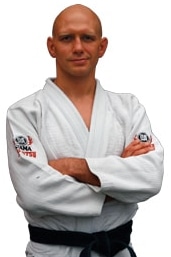
Years ago a big name MMA coach told me that Tabata sprints were mandatory for all his fighters. He argued that this particular exercise acted like a tank of nitrous in a street car; it gave his fighters the ability to generate an extra burst of speed and power when they need it most.
In an MMA context this might be a wild flurry of sprawls and punches. In grappling it might be a desperate scramble to escape a bad situation.
Before we go on, I should say that Tabatas are a type of sprint training where you go as hard as you can for 20 seconds, then take a 10 second break. Repeat that 8 to 12 times, and 4 to 6 minutes later you’ve done one set.
The first couple reps in a set are usually OK, but by rep 3 or 4 a terrible feeling of, “Oh sh*t, I’ve made a HUGE mistake” descends on your world. Remind yourself you only have 3 more minutes to go, and soldier on.
In theory you can do Tabatas on any piece of cardio equipment, but in practice I (and most people I know) prefer to do them on airdyne bikes. You could sprint on a treadmill as well, but the consequences of tripping over your own feet while running as fast as you can in an exhausted state can be pretty spectacular.
I believe Tabatas are the most time-efficient way to get your heart and lungs into shape. A session can take as little as 4 minutes (after a warmup of course), and if you do that three times a week you’ll start seeing results on the mat fast.
Some of that improvement is physiological. Your body’s VO2 Max, anaerobic capacity, and fat metabolism all demonstrably improve.
But a HUGE component of improved fitness is upstairs and psychological.
Going this hard normalises intensity and suffering in your brain. It figures out that you won’t actually die; it’ll only feel that way.
Going to 11 out of 10 on the intensity scale once in a while unlocks a new level in your mind. It dials down the difficulty of everything else by a full notch. What you previously thought was “impossible” is now only “hard.” “Hard” now becomes “medium hard,” and so on.
But don’t take my word for it, this is relatively easy to test. Do Tabatas two or three times a week for a month, and see if it changes your performance on the mat. If they do nothing, then stop.
(Let me know the results of that experiment!
You may not have much time, but you probably have time for Tabatas.
Stephan
P.S. James Deimerdjian and I had a really good conversation about the relative importance of aerobic vs anaerobic training in BJJ on The Strenuous Life Podcast recently.
P.P.S. I like Tabatas, but my favorite method of developing mental toughness is heading deep into the wilderness and doing battle with storms, forest fires, and bears while completely alone. Get my complete how-to guide for that here.



